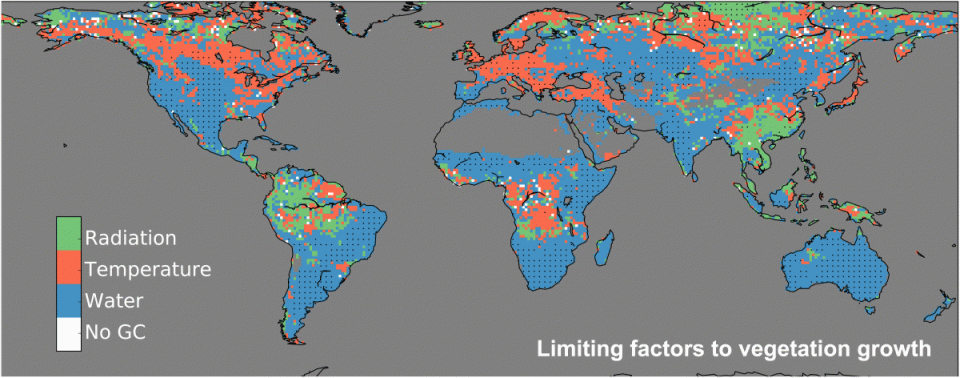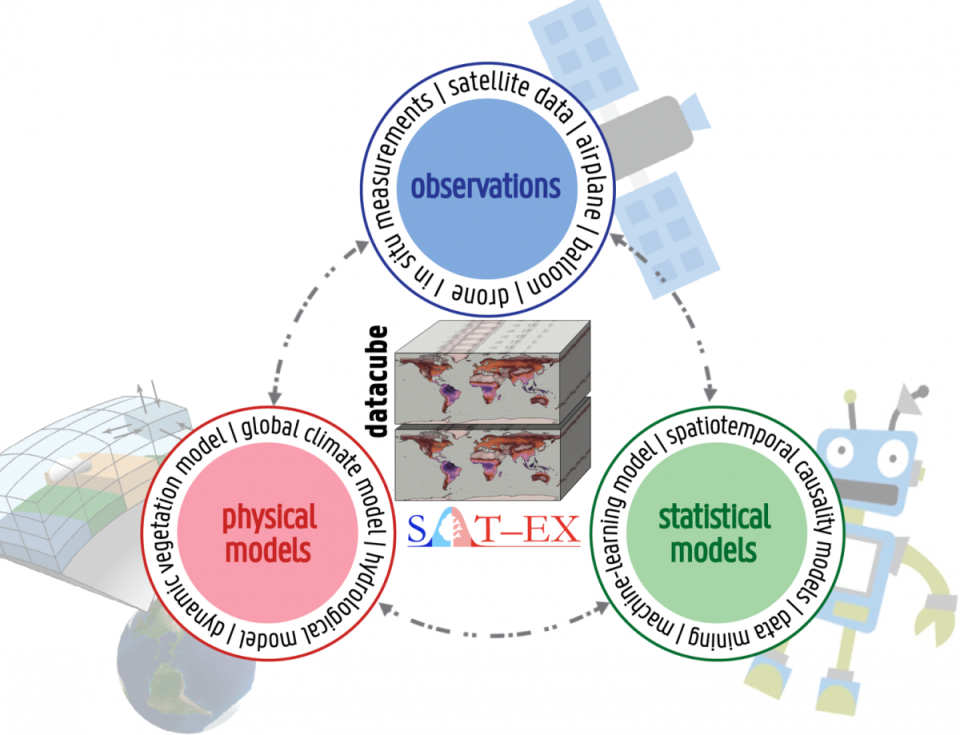Context and objectives
Advances in satellite remote sensing and high-performance computing in recent years are opening up new possibilities to investigate our biosphere, hydrosphere and atmosphere, from sub-daily to multi-decadal time scale.
In this new era of information technology, routine satellite observations can be used to:
- provide process understanding about the drivers of vegetation dynamics at increasingly higher resolutions and planetary scales;
- benchmark the representation of vegetation dynamics in Earth System Models (ESMs).
Given the nonstationary tendency of our climate system, the emphasis of ESM benchmarking should be placed on correctly characterising in our models the cause–effect links between vegetation and its multiple climatic drivers. In other words: present-day vegetation dynamics should not only be correctly represented in our ESMs, but also 'right for the right reasons'. Only then the ability of ESMs to represent the future state of our ecosystems would be reliable. Some recent studies have already used long-term satellite datasets on their own with the focus of studying past extremes; others have applied them with the explicit goal of evaluating climate model representation of general average hydro-climatic patterns. Conversely, the ESM representation of climate extremes has been evaluated by comparison to reanalysis and in-situ measurements. However, long-term remote sensing datasets have not yet been applied to evaluate the global-scale variability of precipitation and temperature extremes in climate models and identify their role in ongoing changes in global vegetation dynamics.
The objectives of SAT-EX strive in that direction.
- To provide evidence of how climate extremes have changed over the satellite era and identify the drivers
behind these changes. - To provide new insights into past changes in vegetation and the role of climate and climatic extremes on these changes.
- To test the extent to which IPCC ESMs reproduce the changes in climatic extremes and the associated response of vegetation.
Project outcome
Scientific results
- Climate extremes have substantially changed in frequency and intensity over the satellite era.
- Climate has a causal effect on vegetation in most of the continental land.
- More than half of the continental vegetated area is primarily controlled by water availability.
- Hydro-climatic conditions have a substantial effect on vegetation browning events.
- Hydro-climate biomes can be directly identified from the observational data by advanced machine-learning.
- Satellite-observed atmospheric composition can help detect the influence of climate extremes on vegetation.
- The influence of climate on vegetation dynamics in ESMs is underestimated.
- Climate models agree on water availability being the most relevant global constraint on vegetation dynamics.
- Just below 3% of global annual GPP is lost via compound climatic extremes.
- Climate models may overestimate the magnitude of interannual variation in NEP.
Societal (including environmental) relevance
Given the scientific nature of the objectives in SAT-EX, its impact is mostly on the work of climate scientists, eco-hydrologists and remote sensing scientists. Interested parties are listed below. Throughout SAT-EX, the interaction with these communities is incentivised and fostered through e.g., annual organisation of conference sessions (EGU conference in Vienna) and the organisation of international events. Moreover, disseminating and advertising results via website, conferences and articles is a priority. Publications are crucial, since the principal body responsible for influencing governments' climate policies is the IPCC, and IPCC assessments are based on peer-reviewed science.
Products and Services
The main products that are delivered are new methodologies and insights in
- the application of remotely sensed observations;
- recent changes in the Earth climate system.
The products are initially distributed in the form of contributions to different international conferences, journal publications, and through data and code sharing via public repositories (https://github.com/lhwm/) and project website.
Potential Users
Given the fundamental scientific objective of the project to evaluate satellite records to enhance our understanding of hydro-climatic extremes and their ecosystem impact, the potential users mainly consist of climate scientists, hydrologists and remote sensing scientists. End-users interested in these findings may include:
- the climate modelling community and climate-related entities (e.g. IPCC, WMO);
- the weather forecast community (e.g., ECWMF);
- Earth observation agencies (e.g. ESA, NASA);
- entities looking specifically at the impact of these extremes on agriculture and ecosystems (e.g. USDA, FAO, UNESCO);
- different scientific research teams working on related topics.
Outreach
SAT-EX: The global ecosystem more limited in water than expected
SAT-EX : L'écosystème mondial plus limité en eau qu'attendu
SAT-EX: Het globale ecosysteem heeft minder water dan gedacht
| Project leader(s): | UGent - Hydro-Climate Extremes Lab (H-CEL) | |||||
| Belgian partner(s) |
|
|||||
| International partner(s) |
|
|||||
| Location: | ||||||
| Related presentations: | ||||||
| Related publications: | ||||||
| Website: | http://www.sat-ex.ugent.be/ | |||||



